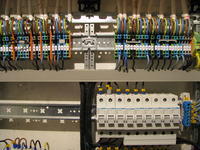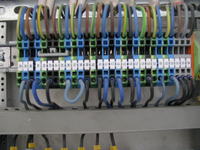Question as per topic ...
And it came about in the fact that when I look at my (2) switchboards the disconnectors are only on the phases (FR 103) and the N wire is not disconnected.
And when I look at various examples it is rather that all conductors are disconnected, except PE of course (using FR 304 for example).
The power supply to the building is TN-C-S, which to the best of my (poor) knowledge means that the PEN distribution is in the ZK outside the building, the building/distribution boards are therefore supplied with 5 core cable.
And it came about in the fact that when I look at my (2) switchboards the disconnectors are only on the phases (FR 103) and the N wire is not disconnected.
And when I look at various examples it is rather that all conductors are disconnected, except PE of course (using FR 304 for example).
The power supply to the building is TN-C-S, which to the best of my (poor) knowledge means that the PEN distribution is in the ZK outside the building, the building/distribution boards are therefore supplied with 5 core cable.





